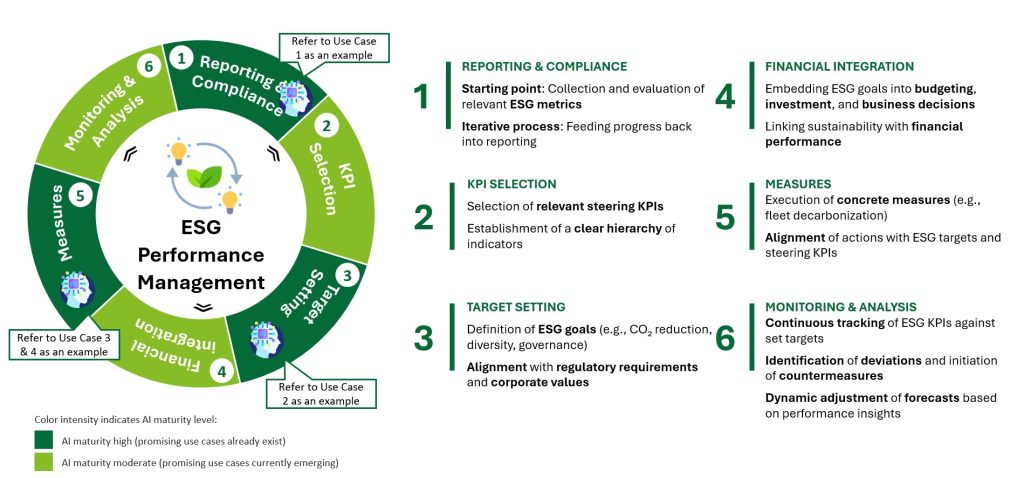ESG performance management is evolving into a strategic discipline. Artificial Intelligence (AI) enables companies to link sustainability with financial planning, improve data quality, and steer ESG goals more effectively, turning compliance into a driver of long-term value.
ESG Performance Management: From Regulatory Pressure to Strategic Opportunity
Sustainability has long become a strategic imperative for companies. According to recent studies, 98% of the companies surveyed report progress in their sustainability goals. At the same time, 99% of them have taken measures to prepare for growing regulatory requirements, for example by creating new roles, investing in technology, or setting up ESG task forces.[1]
This development is no coincidence – requirements for the disclosure of non-financial information are increasing worldwide, with the EU Corporate Sustainability Reporting Directive (CSRD) being one of the most comprehensive and widely discussed sustainability reporting frameworks. The CSRD has established a comprehensive set of guidelines, namely the European Sustainability Reporting Standards (ESRS), that require large companies to systematically report on their environmental, social, and governance impacts, risks & opportunities. In the wake of this and beyond, numerous sustainability reports have already been published. For example, in the financial year 2024 more than 70% of the German DAX 40 companies have published sustainability reports that are either fully ESRS-compliant or aligned with ESRS (as of May 2025).[2] This transparency increases external pressure not only to document sustainability, but also to actively manage and continuously improve it.
However, regulatory compliance is only one side of the coin. Increasingly, companies recognize that ESG performance has a direct and measurable impact on firm value and profitability[3] – both in terms of cost efficiency (e.g., through energy savings, reduced resource consumption, or risk mitigation) and revenue growth (e.g., by strengthening brand reputation or attracting capital).
As a result, ESG is becoming a core element of corporate strategy and financial steering. To capture its full potential, companies must identify the ESG topics most material to their business models and integrate them into strategic planning, mid-term planning, budgeting, and forecasting. This integration aligns sustainability targets with financial objectives, transforming ESG into a tangible driver of long-term competitiveness and value creation. However, according to a survey from 2025, only about half of the companies surveyed have already established KPIs to steer sustainability performance, and a similar share has integrated sustainability into their financial planning processes, most commonly into budgeting and long-term strategic planning.[4] This implementation gap highlights the need for technologies that can connect sustainability ambitions with operational and financial decision-making.
Artificial Intelligence can play a key role in bridging this divide by linking financial and non-financial data, automating analyses, and providing actionable insights. By enhancing efficiency and data quality, AI enables companies to move from retrospective ESG reporting toward forward-looking sustainability management, a system that actively supports strategic and financial decision-making.
Theoretical background: ESG and sustainability performance management and AI use cases
ESG performance management describes the systematic integration of environmental, social, and governance aspects into corporate management.[5] Sustainability is not only understood as a reporting obligation, but as an integral part of performance management. At its core, ESG performance management means translating strategic ESG goals into measurable key performance indicators (KPIs) and linking them directly to decision-making processes. A company that wants to reduce its CO₂ emissions, for example, defines clear target paths, integrates these into investment and budget decisions, and regularly checks whether developments are in line with its strategic ambitions.
As illustrated in Figure 1, ESG performance management is not a one-off exercise but a dynamic, circular process that connects strategic intent with operationalization. It starts with the collection and validation of ESG data to meet compliance requirements. From there, companies select the key performance indicators (KPIs) and define their sustainability goals that will help track progress in a meaningful way.
Once the goals and KPIs are in place, the next step is to embed them into financial planning and investment decisions. Concrete measures are then implemented, (e.g. decarbonizing vehicle fleets or optimizing resource use) and their effectiveness is continuously monitored. If deviations occur, countermeasures are initiated and forecasts adjusted accordingly. The insights gained and progress tracked from this monitoring phase flow back into reporting, closing the loop.
The graphic also implies that ESG steering is not just about data. It’s about decisions. Throughout the cycle, companies need to engage in structured sessions to define targets, evaluate progress, and make informed choices.
To help visualize the role of technology, the graphic uses color intensity to indicate the maturity of AI applications across the different phases. Dark green areas show where AI is already making a strong impact, such as in compliance automation or scenario modeling, while light green areas point to emerging opportunities that are still being explored.
In this article, the focus is on those phases where AI is already delivering tangible value. By showcasing real-world use cases, this article aims to demonstrate how companies can move towards a proactive, data-driven ESG performance management.

Figure 1: AI maturity across the ESG performance management cycle
Artificial Intelligence (AI) as an enabler in ESG and sustainability performance management – Examples from real-world applications
Companies that want to systematically manage their ESG performance often face a multitude of complex challenges, from navigating regulatory requirements to collecting, validating, and analyzing large volumes of sustainability data.
Artificial Intelligence offers a promising way to overcome this complexity by increasing efficiency and improving data quality. The transformative power of AI in the area of sustainability is also confirmed by recent global data: 81% of executives worldwide already use AI to support their firm’s sustainability efforts.[6]
The first step often involves regulatory requirements which often represent the formal requirement for firms to collect relevant sustainability data. Building on this, it is important to define ambitious yet achievable targets and back them up with concrete measures. AI can significantly support this process by accelerating implementation, highlighting risks, and enabling data-driven decisions. It also broadens the perspective: away from purely retrospective reporting and toward proactive, impact-oriented steering. The following use cases illustrate how this transformation path can be shaped in practice.
AI-supported compliance as the foundation for ESG performance management (Use Case 1)
ESG reporting is often the first step on a company’s ESG performance management journey, as firms seek to understand which data regulatory frameworks such as the CSRD or the EU Taxonomy require them to disclose. In practice, 61% of compliance experts surveyed in recent studies rank monitoring regulatory changes as their top priority for the next 12 to 18 months.[7] According to another survey, around three quarters of firms are investing in technology and tools to improve the timeliness and quality of ESG disclosure.[1]
This increasing focus on digitalization lays the foundation for AI-supported solutions that can further enhance reporting quality. Empirical research shows that AI and digital technologies help increase the comprehensiveness and assurance level of ESG reports, strengthening transparency and credibility.[8]
Hence, AI-supported applications can make a decisive contribution here. Through the use of natural language processing and text mining, regulatory documents from a wide variety of sources can be automatically evaluated, compared, and merged into central databases. Automatic notifications provide information about new regulations, while semantic analyses assess their relevance for the company. In addition, AI-supported impact assessments enable an evaluation of the effects on existing processes, systems, and guidelines. This allows risks to be identified proactively and compliance gaps to be closed at an early stage. Companies benefit from reduced costs, greater transparency, and a lower operational burden. With a system of this nature, companies were able to automate their regulatory monitoring processes and reduce the analysis time for new regulations by around 50%. AI-based reporting solutions are already emerging as the next step of this journey, but go beyond the scope of this paper.
AI-supported scenario modeling for integrated target setting and emissions planning (Use Case 2)
Once regulatory reporting requirements have been met and the status quo has been recorded, the next crucial step follows: Defining effective and economically viable targets. So far, we have seen that the focus here is and has been on reducing greenhouse gas emissions. According to a report from 2024, climate change remains one of the top three priorities for global executives, ahead of geopolitical risks and talent shortages.[7] 70% of companies expect climate change to have a significant impact on their strategy and operations over the next three years.
In this context, AI-supported methods can help organizations translate climate ambitions into concrete and data-driven targets. By integrating emissions data into financial and operational indicators, predictive models can simulate how changes in production volumes, energy mix, or technology adoption influence both emissions and cost structures. AI-supported time-series analyses allow for continuous monitoring and recalibration of targets as business conditions evolve, while marginal abatement cost modeling identifies the most cost-efficient measures across sites or business units. This enables decision-makers to balance environmental objectives with financial realities in near real-time.
A practical example illustrates this. An international industrial company used AI-based scenario modeling to establish a comprehensive emissions baseline and evaluate various decarbonization pathways. The analysis linked emissions trajectories with investment plans and helped prioritize projects based on their abatement potential and economic impact. As a result, the company developed a clear roadmap toward carbon neutrality, improved data quality, and achieved greater transparency on cost-effective mitigation options.
Decarbonization of vehicle fleets through data-based optimization (Use Case 3)
Once the targets have been defined, the focus shifts to practical implementation: How can ambitious (climate) targets be translated into effective measures? For many companies, the transport sector is a promising starting point. Not only is it responsible for around a quarter of greenhouse gas emissions in the EU according to a report from the European Environment Agency (EEA)[9] but despite technological advances, it has seen a 26% increase in emissions since 1990. One of the most effective levers is the electrification of vehicle fleets. AI-supported models make it possible to record the current emissions and operating costs of a fleet in detail, identify suitable vehicles for the switch to electric mobility, and develop multi-year transformation plans. These plans take costs and the necessary charging infrastructure into account as well as the regulatory requirements and available funding mechanisms. In addition, optimization models can incorporate predictive maintenance and intelligent route planning to further reduce operating costs and downtime. This provides companies with an end-to-end roadmap for decarbonizing their fleets, combining environmental goals with economic viability and making a decisive contribution to achieving the set targets.
Similar data-driven optimization approaches are expected to play an increasingly important role across other ESG dimensions as well, for example, in supply chain transparency, or social impact measurement, helping organizations manage sustainability performance more holistically.
Forest Foresight – AI-supported early detection to combat illegal deforestation (Use Case 4)
Sustainability goals and their management do not end at the boundaries of individual companies. International organizations and NGOs are also increasingly using artificial intelligence as a tool to identify ecological risks at an early stage and take effective countermeasures. A prominent example is the fight against illegal deforestation. Forests are indispensable for climate protection, biodiversity, and the livelihoods of billions of people, yet their destruction is progressing at an alarming rate. In 2021 alone, primary forest areas the size of Denmark were illegally cleared, and deforestation remains the second largest source of global greenhouse gas emissions.[10]
Traditional monitoring systems usually only detect illegal clearing after it has already taken place. AI-based platforms use machine learning models in combination with satellite images and geodata to predict risks up to several months in advance. They create risk maps that highlight hotspots and issue alerts and hence allow for targeted action before irreversible damage occurs. The benefits extend beyond environmental protection. Companies reduce ESG risks in their supply chains, governments proactively meet regulatory requirements, and global biodiversity is protected in the long term.
These examples show that AI can be used along the entire ESG performance management cycle. AI facilitates entry via regulatory compliance, supports the definition and planning of goals, accompanies implementation, and ultimately also contributes to global risk prevention. This makes it clear that AI is not just a tool, but a key instrument for enabling ESG performance management that is future-oriented, data-based, and effective.
Summary / Conclusion
Today, sustainability is more than just a strategic buzzword; it is a central component of modern corporate management. ESG performance management aims to actively incorporate ESG-criteria into strategic and operational decisions. It creates transparency, strengthens resilience, and makes sustainability goals measurable, ultimately contributing to long-term profitability, stakeholder trust, and sustained enterprise value.
Although the use of AI in ESG performance management is still in its early stages, it is set to fundamentally transform the way organizations steer and measure sustainability performance. The use cases presented show how AI already supports ESG performance management. AI creates the basis for efficiently managing complex regulatory requirements, translating goals into resilient scenarios, planning operational measures based on data, and identifying global risks such as deforestation at an early stage. This makes ESG performance management not only more precise, but also more action-oriented.
In order to fully exploit this potential, companies must organize their data flows reliably, develop a consistent datapoint framework, clearly define responsibilities, and design processes in such a way that sustainability is taken into account across all business areas. While regulatory requirements provide the common language and structure for ESG reporting, effective steering focuses on a carefully selected subset of datapoints that are truly relevant for decision-making and value creation. In other words, compliance defines the framework, but strategic ESG steering determines the priorities within it.
The growing interdependence of sustainability and technology is also reflected in latest global data: 45% of executives rank climate change and sustainability among their top three business challenges – on par with AI and technology adoption.[11] This underscores that sustainability and technological innovation are no longer separate agendas but mutually reinforcing pillars of strategic value creation.
Looking ahead, ESG performance management will increasingly evolve into a dynamic, technology-based management model. Companies that lay the necessary foundations today and systematically integrate the use of AI will not only ensure regulatory compliance, but also long-term competitiveness. In the future, financial and non-financial planning will become increasingly interconnected, as ESG metrics and business performance indicators will be managed within a single, data-driven framework. Sustainability will thus not only be reported on, but actively managed and shaped.




